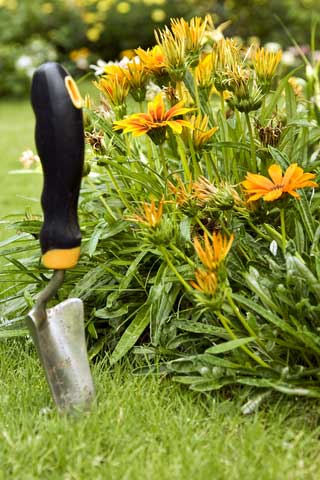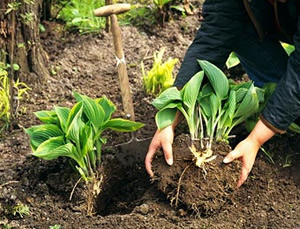Move perennials in spring or fall

Most perennials can be moved and transplanted without too much trouble. Transplant perennials when the weather is cool, even a little rainy, if possible. Early spring and fall care are best times for transplanting. When the weather is cooler, the plants do not require as much water.
DO NOT move or transplant perennials while they are in bloom. As a general rule, wait a few weeks after they bloom before moving. If a plant blossoms in the fall, transplant them in the spring.”
Whenever a plant is dug up, it suffers some root loss. This reduces the ability of the plant to take up water and cool itself. When moved in hot weather, its damaged root system is unable to supply enough water to cool the plant. It can literally burn up.
When digging perennials remove the tops. This can be done by cutting them, waiting until after the tops have died back, or transplanting them before growth starts in the spring. This reduces the draw on the roots, allowing them to use their energy to grow and establish themselves rather than putting effort into supplying water.
Most perennials can be moved by simply digging a large shovelful of soil and roots with the plant and placing it in the new location, he says. While relocating perennials, remember this is also a good time to divide those that are overgrown. If the plant has outgrown its area, remove half the plant, leaving the other part to fill in the area.

Apply about three to four inches of mulch around perennials when transplanting in the fall. This helps hold the moisture and keeps the ground warmer, promoting root growth well into the late fall. Transplant three to four weeks before the ground freezes. Allow time for the roots to establish and not be heaved out during winters freezing and thawing weather.
Also allow the plants to become established before fertilizing. If they have been moved in the fall, fertilize the following spring. If transplanted in the spring, wait two or three months before fertilizing.
Do not be afraid to move the perennials in your flower beds. Moving one or two plants can change the whole design of the landscape. This may allow a few of those hidden plants to be seen once again.

Leave a Reply
You must be logged in to post a comment.